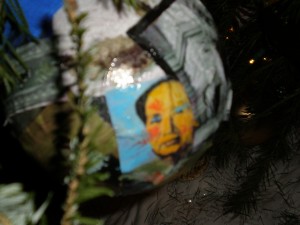It isn’t often that matters of art enter the political news cycle. The Obama administration is determined to change that. Over the holiday week, Andrew Breitbart’s Big Government drew its readers’ attention to the ornamentation on the White House Christmas tree–in particular, an ornament featuring a picture of the Chinese dictator Mao Zedong.

This season’s Christmas decorations, recycled and reappropriated by “community groups” with ornaments from previous White House installations, were the brainchild of Simon Doonan, the Pop Art gadabout tapped by the White House for the occasion. Doonan is most well known for his controversial window displays at the Barneys New York department store, which have included dioramas of Margaret Thatcher in dominatrix wear and Dan Quayle as a ventriloquist’s dummy.
The news of the White House’s holiday hijink reached around the globe. The most interesting commentary came out of the smackdown between the art critic for the Los Angeles Times Christopher Knight and Breitbart. I have had my run-ins with Knight myself. On this occasion, Knight thought he outdid the right-wing commentators by making a distinction between any old portrait of Mao and “Andy Warhol’s ‘Mao ‘”–from which the White House ball derived.
“The image is one of a very large series of silkscreen paintings and prints the late Pop artist made of Mao,” wrote Knight. “Warhol’s parody transformed the leader of the world’s most populous nation into a vapid superstar–the most famous of the famous. The portrait photo from Mao’s Little Red Book is tarted up with lipstick, eye-shadow and other Marilyn Monroe-style
flourishes.” To which Breitbart responded:
If Bush had one kitschy Hitler ornament among 1000s of others, I’m sure you’d refrain from judgment, right?… How the artist of the Mao picture negates the inappropriateness of honoring the world’s worst mass murderer in the history of the world in the White House is beyond my pedestrian education.
Now, I admire Breitbart’s rhetorical faux naivete, and of course there is a difference between “Andy Warhol’s Mao” and the Mao portrait you find looking down over Tiananmen Square. I doubt the White House intended the offending ornament to be an overt celebration of the Great Leader. Yet it is equally naive to claim, as Christopher Knight does, that Andy Warhol’s Mao is a straightforward attack on the dictator and therefore exculpatory. The image of Warhol’s Mao is neither pro-Communist nor anti-Communist. It is simply parody, and parody with the broadest of implications. Warhol’s Mao is an attack on an icon for the sake of its iconography, not for what that icon represents. This is why Doonan included it, and why we should be wary of it.
The problem with the White House Christmas Tree isn’t Mao per se but another three letter word: Pop. Simon Doonan’s choice of Christmas ornaments, “decorated” in a Dada assembly of camp images from drag queens to historical figures, is a kitschy affront to the icon they are meant to adorn–the Christmas tree itself. Doonan’s pop sensibility might be appropriate for the window displays at Barneys New York, where it can poke fun at the materialism of the Christmas season, but Pop Art irony has no place in what should be the least ironic house in the nation. For this reason Doonan’s White House tree should be criticized.
COMMENTS
Please let us know if you're having issues with commenting.